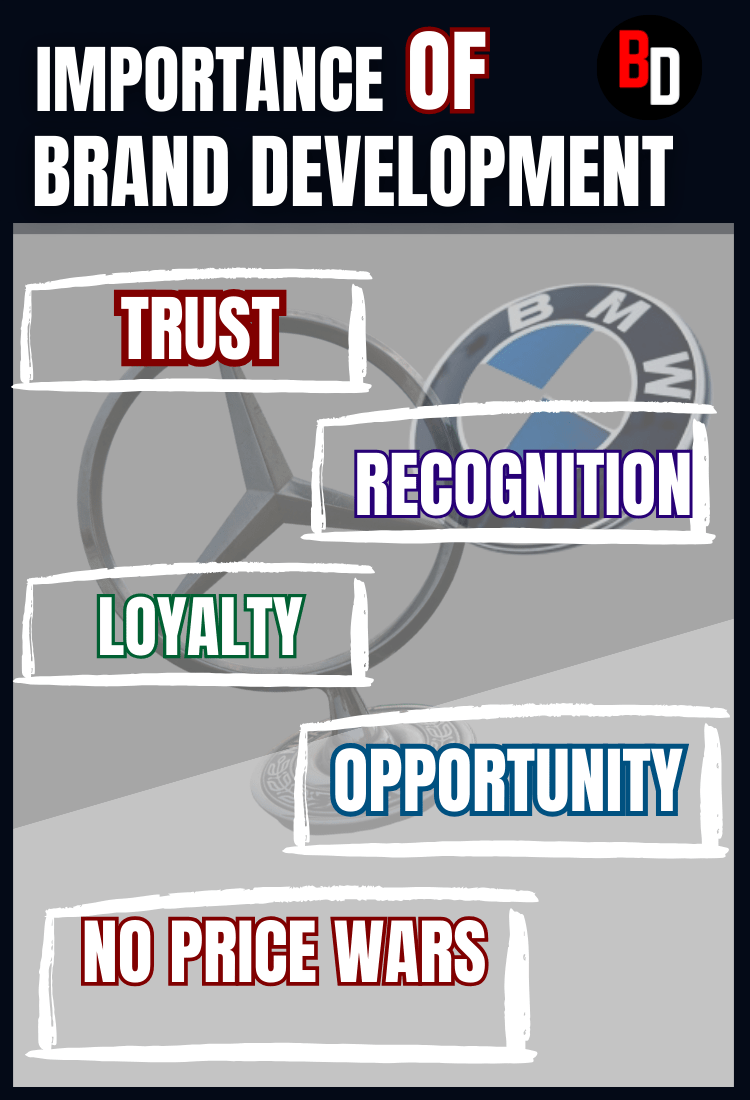What is brand development? this question is very big and covers an enormous amount of topics in it. Those days were gone when companies used to create a brand image through lots of advertising and using gimmicks or quick fixes.
In today’s time developing a brand is no longer an easy task it requires lots of dedication and time, and by time, I mean several years.
Nowadays there are lots of companies that are offering the same product with the same benefits and functions, you can term this as product parity.
Product parity is in every industry but by developing a great brand a firm can avoid price wars and continue to achieve profits even when the prices of the products and services are increased.
CONTENT
Key components of brand development.
Importance of brand development.
What is brand development index?
The 3 C’s of brand development.
What are the steps in brand development?
Frequently Asked Questions (FAQ)
So, what is brand development?
Brand development is a strategic process through which brands create and strengthen their brand image or identity with the help of various strategies and techniques. It’s a part of upstream marketing. A good brand image helps the company establish a positive reputation among its customers and increases its visibility.it is also important for any business to survive in the long run.
Brand identity development is a long and ongoing process, it requires time and continuous effort.
It includes activities like market research, creating brand strategy, creating brand identity and message, developing guidelines, engaging with customers through different platforms, maintaining good public relations, and most important thing is to providing them value.
Most of these activities are handled by a brand development manager. He is accountable for managing all the tasks and strategies and creating a positive brand image.
Also Read:
Key Components of Brand Development

It has several key components which help a business to build a strong and reputable brand. These components are-
- Brand strategy– Building a brand without a brand strategy sounds like sailing without a compass. A brand strategy is the most crucial component that helps to differentiate your brand from others. Making an effective brand strategy can help you to beat your competition and attract more customers.
- Brand identity– Just like the above one, brand identity is also very important. Building a brand without an identity is like raising a baby without a name. A brand identity consists of logos, color combinations, slogans, style, typography, tone, and many more.
It should be attractive and unique because It helps your customers to remember your brand.
- Brand experience– experience is the most important intangible value that companies can offer. A good customer experience is equal to a loyal customer. Tangible values are always expected but if you want to capture more market then you have to go beyond tangible value.
- Brand consistency– It’s an ongoing process you have to keep enhancing your values in the brand to make it well established. You have to use uniform use of communication on all platforms. Consistency will also spread awareness about your brand. It’s one of the main reasons for brand growth.
- Brand positioning– Just as every baby needs a name to define their unique presence, every brand needs a strong identity to shine in the world. Positioning is all about how you want your customers to see your brand. We will discuss brand positioning in this article in more detail.
- Brand story– to connect the customer emotionally with the brand you need to create a most effective brand story that addresses their problem and also provides them a solution. The story should be relatable so that customers can feel connected, it helps to build trust and loyalty. It also makes your brand more memorable.
Importance of Brand Development.

- Recognition– A well-established brand helps a customer recognize your brand over your competitors. It helps your customers to differentiate your brand from other brands. A brand that is recognized is always in the spotlight.
- Trust and loyalty– A great brand develops trust and loyalty among your customers. No matter how good your products are if you are not well established yet then people will not trust you easily. Once you develop the trust then you will have the competitive advantage.
- Avoid price wars– if you are in the hearts of your customers then you don’t have to compete with other brands over price. No matter what your prices are, you will always be the first option(it doesn’t mean you should charge high prices just for short-term gains). You should always be fair with prices as well.
You can also charge a premium price only if you are offering premium value.
- Opportunities– A well-established brand will have more opportunities because it can enter any market it wants. they will face fewer difficulties because of their good reputation in the market. As a matter of fact, people will buy their product without any hesitation.
For example- Amazon started as an online bookstore but expanded its business with cloud computing services.
Also Read: How Boat became the No 1 Brand in India and came in top Brand of the World
What is the brand development index?
While developing a brand, a company should measure its BDI(brand development index) it’s a metric that is used by the company to measure its brand strength and performance in a particular region or segment.
It’s an important tool for marketers to measure performance.
What are the 3 c’s of brand development?
There are lots of C’S in brand development but the most important are –
1. Clarity-
A brand should have clarity about its vision, mission, and values. Clarity helps the brand to convey its message to its target customers and also helps the consumer to understand what the brand is trying to say.
A brand should be transparent and easily understandable by its customers, it can lose its audience if it fails to provide clarity in its message.
The PR chief of Goldman Sachs once said “If it’s too complicated to explain to ordinary rational people, then maybe it’s a business we ought not be in ”
2. Consistency-
Consistency plays a vital role here. It refers to maintaining uniformity in all aspects of brand communication. A brand should convey the same message through all platforms.
It should also keep its identity, message, and tone constant for better brand recognition.
consistency is important because-
- It develops trust among consumers
- It helps to make a brand recognizable.
- It improves perception
3. Credibility –
Refers to the trust and reliability a brand has built among its audience. Credibility helps the brand to pull loyal customers. A credible brand is always seen as dependable and honest. people can easily trust them.
A credible brand helps a brand to survive in a long run game and it also encourages customers to choose it over competitors.
A brand can become credible by:-
- Providing high-value goods and services
- Setting high-quality standards
- Practicing fair management practices without bypassing consumer needs.
- Enhancing their performance day by day.
- Engage with customers.
What are the steps in brand development?
Before jumping on the steps, you should know that brand building is a long game. A company can’t build a brand in a short period. It needs constant effort and dedication.
Most companies use quick fixes and gimmicks to build a brand which is not a good way, using these techniques can erode a brand’s image.
Now let’s discuss the steps:-
Step 1 – know your audience
Before building a brand you should know who your audience is, What are their needs, and how you will fulfill them?
It’s a crucial part because if you don’t know your audience then you will not be able to set a clear vision. You will also have difficulties in making strategies. In this step, you have to find out their demographics, motives, and needs so that you can reach them with your brand.
To know your audience you have to do the –
- Market research– you have to research so that you can find every single detail about the type of customers you want to target. You can use surveys, interviews, and questionnaires to gather information about the customers.
Market research is great because in this you will know the needs and wants of your customers.
- Creating buyer personas- also known as user personas or marketing personas. It is a fictional profile of a buyer that represents your ideal customers. It includes information about the customer like age, location, income, etc.
we can say it provides you a 360-degree view of an ideal buyer. These are very helpful in making effective marketing campaigns.
Step 2. Build a brand strategy
Building a strategy is a crucial step and a company can only build a good strategy after examining its environment because the environment is the groundwork for providing value to the customers. A great brand strategy results in excellent brand growth.
While building a strategy you need to have clarity about the –
- Your visions, mission, and your core purpose.
- Your competitors – know how your competitors are performing in the business and what type of product they are offering to their customers.
Do a proper competitor analysis.
- Gather information about the environment – know about the political, legal, technological, social, economic, and legal environment.
Gathering information from the environment can help you make a powerful strategy.
Developing a brand needs to constantly adapt to its environment because the environment is uncertain and it can directly or indirectly influence the activity or performance of the business.
- Know your strengths and weaknesses- use your strengths to grab the opportunity from the market and work on your weaknesses to avoid threats from the external environment.
Step 3- position your brand
Once you have built a good brand strategy then move on to brand positioning. It refers to how you want your target audience to perceive your brand. It includes-
-Building a USP(unique selling proposition)- In this you have to find out what makes your brand unique and how you are different from your competitors. If you have a great USP then consumers will automatically pick your product over your competitors.
-Making promises- in this you have to make a promise to your target customers about what your brand will do for them. Make sure to fulfill your promise otherwise, your customer will feel disappointed.
For example- NIKE promises to bring inspiration and innovation to every athlete in the world and it also fulfills it.
Just like NIKE make sure your brand also keeps the promise.
Always remember to “promise what you can deliver and deliver what you promise.”
Step 4- building a brand identity
Now it is time to build an identity through which people can recognize that it is your brand. This step requires creativity because making an attractive brand identity can influence your sales.
An attractive brand identity –
- will set a good first impression.
- It will help your customers remember your brand.
- It will attract more customers.
- It will give you a competitive advantage.
Building a brand identity includes-
- Creating a brand name
- Creating a logo
- Creating a tagline
- Creating a visual identity – like imagery, typography, using good color combinations, etc.
step 5- Create a brand message and voice
brand message- Your brand has to generate a message to convey what your brand stands for. A strong brand message will build trust and establish a strong relationship between the consumer and the brand. It also differentiates your brand from the competitors.
After creating a message a brand needs to communicate that with its customers because proper communication brings clarity and clarity brings trust.
Brand voice- a company has to set a tone or style of communication, it can be friendly or professional.
For example-“let’s start together and make some magic together” As you can see it sounds very friendly and approaching.
Here’s another example- “let’s work together with our advanced solutions to unlock your full potential” As you can see it sounds more professional and goal-oriented.
So creating a brand message and tone depends on what is the core goal of your brand and how you want your brand to be perceived in the minds of your target audience.
Step 6- time to introduce your brand in your business
Now it’s time to tell people about your brand by developing a great brand story. In the story have to tell the targeted audience about your brand mission, its USP(unique selling proposition), and the journey behind your brand creation.
Create a great brand presentation that gives an overview of your brand and also tells its USP, its key product, and services.
You can also introduce your brand through online platforms like-
- social media– you can create brand profiles that will help you to engage with your audience. You can create posts and videos to give them information.
- Websites- you can create a user-friendly website through which-
a). They can know about upcoming products.
b). They can send complaints or feedback about your products.
c). They can also contact you and get information about your brand.
- Online campaigns – you can run campaigns to raise brand awareness and attract customers, using Google ads or Facebook ads to run your campaigns.
- And many things like- sending personalized emails, SMS, etc.
Step 7- monitoring your brand
Integrating your brand is not enough, monitoring your brand is a crucial part. You have to continuously monitor it to know whether it’s working or not. Continuous monitoring is necessary to know about market changes and it helps to respond effectively to any issue.
You have to measure performance by tracking key performance indicators to know the success of your branding efforts and have to make changes according to the environment.
You also have to keep improving your brand through feedback, adapting to the market changes, and grabbing opportunities that will boost your business.
Step 8 – Rebranding
This step should only be used when-
- If the industry is changing very rapidly or when new competitors are entering, so by doing rebranding you can stay relevant, and competitive, and differentiate yourself from other businesses.
- If the company is changing its business model or entering new markets, then it requires rebranding.
- If the company image has become outdated or your brand image no longer reflects your missions and values, then it requires rebranding.
- And there can be many legal reasons for rebranding like trademark issues, government policy issues, etc.
Summary
Brand development is a process that involves creating a strong brand identity to ensure its success. It’s a mixture of tactical and strategic marketing but strategic marketing has an important role here. It requires creativity, patience, and dedication because it’s a long process.
We can also say it’s pervasive in nature because it doesn’t solely depend on the marketing department. It requires collaborative efforts across multiple departments within the organization and also from its employees.
Brand development mostly focuses on creating trust, loyalty, and presence in the market. This article gives you a detailed guide to brand development, its key components, importance, and steps.
“We hope you found this article helpful. Happy branding!”
Also Read: Sugar Cosmetics: How Became the Brand
FAQ
Q1. Why do we need to develop a brand? Or why do consumers prefer brands with strong value?
Ans. Developing a brand is very important, especially in this competitive environment where several businesses are selling the same product or service with little differentiation. A well-established brand or a brand with strong value provides reliability, trust, and loyalty which automatically differentiate the business from its competitors.
Q2. why brand development is pervasive in nature?
Ans. It’s pervasive in nature because it doesn’t solely depend on the marketing department. It requires collaborative efforts across multiple departments within the organization and also from its employees.
Q3. How does brand development = value delivery?
Ans. Your brand can only grow if you provide value to your customers and fulfill their needs and wants. You have to put value in the center and sell effective solutions rather than just providing them with products.
most businesses are in a survival phase because they are just selling products.
Q4. When should brands enter new markets?
Ans. Entering new markets can be very risky, especially for new brands. It’s a strategic approach. A brand should only expand if its current market is at its peak or growing well.
A brand should not enter a new market without competitor and environmental analysis.
Q5. How can a brand build loyalty and trust among its customers?
Ans. Loyalty and trust are two things that can’t be built overnight. A business can only achieve this by practicing fair management practices like- being honest and fair, providing high value at a reasonable price, and also by listening to customers and fulfilling their needs.



